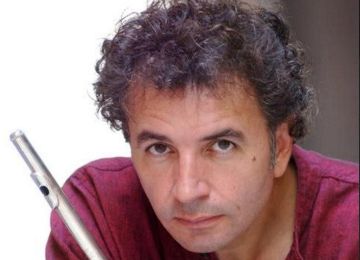|
Symphony
FROM THE NEW WORLD TO THE OLD WORLD
by Peter Lert
Saturday, June 14, 2025
Chamber
MC2 DUO RECITAL CLOSES 222'S SEASON
by Terry McNeill
Saturday, June 14, 2025
Choral and Vocal
CANTIAMO SONOMA'S LUSCIOUS A CAPELLA SINGING IN SEASON ENDING CONCERT
by Pamela Hicks Gailey
Sunday, June 8, 2025
Symphony
SRS SEASON ENDS WITH RESOUNDING TA-TA-TA-BANG
by Terry McNeill
Sunday, June 1, 2025
Symphony
YOUTHFUL VIRTUOSITY ON DISPLAY AT USO'S MAY CONCERTS
by Peter Lert
Saturday, May 17, 2025
Symphony
MYSTICAL PLANETS AND LIVELY GERSHWIN ORTIZ AT FINAL SRS CONCERT
by Peter Lert
Sunday, May 4, 2025
Symphony
VSO'S CONCERT MUSIC OF TIME, MUSIC OF PLACE
by Peter Lert
Sunday, April 27, 2025
VOCAL ELEGANCE AND FIRE AT THE 222'S RECITAL APRIL 26
by Pamela Hicks Gailey
Saturday, April 26, 2025
CANTIAMO SONOMA SINGS AN INSPIRED GOOD FRIDAY MOZART REQUIEM CONCERT
by Pamela Hicks Gailey
Friday, April 18, 2025
DRAMATIC SHOSTAKOVICH SYMPHONY CLOSES PHILHARMONIC'S 25TH SEASON
by Terry McNeill
Sunday, April 13, 2025
|
 |
 Flutist Jean Ferrandis |
DUET FOR FLUTE AND BATON
by Steve Osborn
Sunday, October 9, 2016
Sustain, sustain, sustain! That exhortation often passes the lips of music teachers, and their students’ success is often judged by how well they master the concept. Two students who mastered it to perfection are Bruno and Jean Ferrandis, the “Brothers in Black” who led and soloed in the Santa Rosa Symphony’s October opening set of concerts in Weill Hall.
The basic idea of sustain is to play all the way through the note and the phrase, never letting the energy peter out. This quality is nowhere more necessary than in wind instruments, where the player has to control intake and expenditure of breath without running out of air or gasping for more. Jean Ferrandis, the flute soloist for his brother’s orchestra, proved himself a master of sustain in two radically different flute concertos by Bernstein and Mozart, along with a breathtaking encore by Debussy.
Not to be outdone, brother Bruno coaxed an equal level of sustain from his wonderful orchestra, which kept driving forward through pieces fast and slow, never letting their intensity falter. Each piece offered its own gripping narrative, from the haunting beginning of Britten’s “Four Sea Interludes” to the propulsive climax of Beethoven’s Eighth Symphony.
Soloist and orchestra were equally praiseworthy, but let’s begin with Jean, who opened with a heartfelt rendition of “Halil,” Bernstein’s nocturne for flute and small orchestra. He immediately displayed a beautiful, even sound that carried to the farthest reaches of the balcony, where music reviewers tend to sit. He sustained his notes well beyond the limits of ordinary breath without a hint of effort or strain.
“Halil” itself is somewhat amorphous, with a luxuriant opening melody that passes back and forth between the soloist, the principal flutist (Kathleen Lane Reynolds), the concertmaster (Joseph Edelberg) and principal violist (Elizabeth Prior). This dialogue transforms into a Broadway-style dance and is then replaced by a lengthy section where the soloist is accompanied only by percussion. Here Jean shone, holding the audience in rapt silence as he wove in and out of the percussive backdrop. The piece finally reverts to the opening melody, repeatedly employing a descending six-note phrase, and it ends with a long note from the flute, which Jean stretched to the limit.
In “Halil,” Jean proved a master of atmospherics, but in Mozart’s G Major flute concerto (K. 313) he displayed an equal mastery of relaxed precision. In Mozart the soloist is fully exposed, and even the slightest misstep can turn into a tumble. Jean negotiated Mozart’s trickiest passages with ease, dancing along with a feathery tread. His phrasing in the beautiful second movement was exquisite, matched only by his virtuosity in the third.
After a well-deserved standing ovation, Jean encored with Debussy’s “Syrinx” for solo flute, a brilliant showcase for his breath control and tone. After all his work with the orchestra, it was a revelation to hear him all alone. If anything, his sound was even more gorgeous than before.
Following his brother was no easy task, but Bruno displayed his own mastery of conducting sustain in a riveting performance of Beethoven’s eighth symphony. The orchestra produced a tight, unified sound from the beginning, with the strings playing unerringly in the fastest passages. The precision was particularly evident in the sprightly second movement, where the orchestra sounded at times like a string quartet. The minuet third movement tempo was a bit too deliberate, but the French horn duo over cello arpeggios was delightful. The real fireworks occurred in the finale, which builds up bit by bit to a stunning climax. Here the sound was transparent, with no mud to cloud the headlong rush to the end.
The Beethoven was great, but the piece that opened the program, Britten’s “Four Sea Interludes,” was every bit its equal. Taken from his 1945 opera “Peter Grimes,” the interludes portray the sea in its multiple moods and rages. The first interlude begins with a high phrase in the violins that features a sustained trill. The unity of the strings here was impressive, and it set the stage for a sensitive, intricate performance of Britten’s majestic score.
Conductor and players handled the dense orchestration with ease and grace. Many passages stood out: the handoffs of the compelling staccato theme from woodwinds to strings to brass; the insistent plucking of the harp; the compelling force of the kettledrums. All these and more combined for a fiery and dramatic performance that left one wishing to hear the entire opera, arguably Britten’s greatest work.
|

